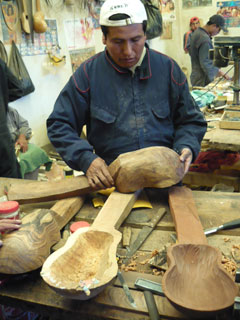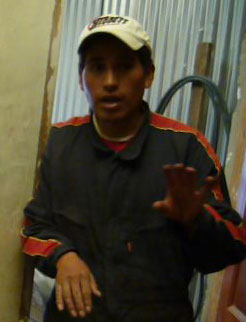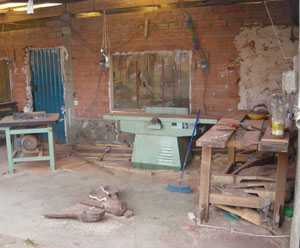Carlos and Pedro Quispe Torrez are two brothers who are luthiers in El Alto. We spent an afternoon with them to get to know their work and hear their story...
 At noon on Wednesday we met at the rural market in one of the neighborhoods in El Alto. Carlos, a good looking young man, drove us in his car as he was looking for batteries. The workshop isn't far, and two minutes later we arrive at the huge metal gate of the Quispe Torrez property where we met Pedro who invited us into his office. We began our interview in a relaxed atmosphere, and they simply told us their experiences.
At noon on Wednesday we met at the rural market in one of the neighborhoods in El Alto. Carlos, a good looking young man, drove us in his car as he was looking for batteries. The workshop isn't far, and two minutes later we arrive at the huge metal gate of the Quispe Torrez property where we met Pedro who invited us into his office. We began our interview in a relaxed atmosphere, and they simply told us their experiences.
They come from Walate, a small village on the banks of Lake Titicaca. From the time they were small they began making musical instruments since they come from a community where several Aymara instruments originated.
Pedro, at 18 years of age after completing his military service, began working as an apprentice at the Achá workshop, which is a well-known La Paz luthier that participated in international fairs and was quite popular with the best Bolivian charango players. He spent nine years there learning his craft.
His skill is completely experiential since he never studied the craft outside of what he learned at the hands of a master craftsman who taught the knowledge that distinguish the finish of each charango.
 This type of apprenticeship represents an investment on both sides - on the one hand, the master craftsman instructs the apprentice while he works for him; and on the other hand, the apprentice works in exchange for learning the craft.
This type of apprenticeship represents an investment on both sides - on the one hand, the master craftsman instructs the apprentice while he works for him; and on the other hand, the apprentice works in exchange for learning the craft.
However, often apprentices think they have learned everything and start their own shop, but few are equal to or better than their master in order to compete with him or her in the marketplace.
In 2005, after completing his apprenticeship, Pedro went into partnership with his brother Carlos whom he taught, and together they established their workshop in El Alto where they provide complete training (making the charango from beginning to end) for ten or so young apprentices.
Crafting a single charango (which includes varnishing and drying) takes at least seven whole days. The charangos from the Quispe workshop are very high quality since they devote the careful attention necessary at each stage of their construction.
For example, even if the wood arrives from Santa Cruz already dry, they let it dry a year before they use it.

Drying the wood is extremely important since if it has even a trace of moisture, the charango neck will warp over time.
All the materials are high quality (palo santo, jacaranda, naranjillo and ebony woods, etc.) in order to make luxury charangos for students, professionals and semi-professionals.
They count many great charango players from Chile among their customers, and they can confirm that wherever they take their charango, they return with orders and e-mails. They make all types of charango, large and small with normal strings, walaychu (the smaller relative tuned a 4th higher), ronroco (larger and tuned an octave lower), charangos for women, etc.
The Quispe brothers are prompt in delivering their products, and their quality make them popular exports. In only five years they have become the most highly sought after luthiers of La Paz, since their charangos are economical in spite of being such high quality.
They export mainly to Chile where Bolivian charangos are most in demand. Each one is made from beginning to end with the love, service and dedication of a great master.


